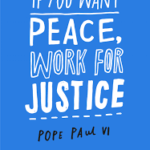Can Peacebuilders Demand Social Justice, Too?
How can we stress working for peace when there are massive injustices in the world, especially if working for peace could serve to perpetuate those injustices?
I’ve worried about this question for the thirty-five years when I’ve thought of myself as a professional peacebuilder as well as a political activist. It has been nagging at me in new ways ever since I began working with my now co-author and friend Doug Irvin-Erickson, who approaches it first as a human rights activist and then as a peacebuilder. By contrast, the more I’ve defined myself as a peacebuilder, the more I’ve put social change questions second, despite the fact that I became a peace activist in the first place because I saw the peace movement as a vehicle for achieving broader social change.
Doug’s Question
 I met Doug at a launch party for his book on Raphael Lemkin and the study of genocide. In it, he talked about creating architectures for atrocity prevention in countries that had experienced them and didn’t want to see them repeated.
I met Doug at a launch party for his book on Raphael Lemkin and the study of genocide. In it, he talked about creating architectures for atrocity prevention in countries that had experienced them and didn’t want to see them repeated.
Perhaps because his launch took place during the week of President Trump’s inauguration, my first reaction was to ask him about how we could create such an architecture here in the U.S. We’ve been working together on that ever since, and he keeps raising a version of that question I posed in the first paragraph. It’s, of course, not a new question and is often reflected in the quote about working for peace and justice in this image that was vividly expressed by Pope Paul VI in 1972.
Like most genocide prevention or human rights activists I know, Doug tends to pose the social justice questions first, especially when we discuss situations in which genocide or some other mass atrocity seems imminent.
We’ve spent a lot of time working through these differences for the book we’re doing, but we hadn’t gotten very far until one day last week which we spent working on the book we’re writing. While on the Metro ride home, I finally came up with the first part of an answer that can help us address what we could do when those two core values that we peacebuilders hold near and dear conflict. Later in the week, we got even farther, but I’ll wait until next week’s blog post—and another week’s thought—before dealing with concrete ways forward.
Answer #1. Speaking Truth to Power
First, there are some questions that we peacebuilders deal with for which we should definitely not start out trying to “get to yes.” That may have been our first inclination, especially you came into this work after having read books like Roger Fisher and William Ury’s Getting to Yes (and, in my case having had the pleasure of working with Bill Ury from time to time over the years).
Yet, there are times when you have to say “no” first. And do so emphatically. When I encounter examples of things I can’t abide which—at least in my case—includes racism, sexism, damage to the environment, and more, I have to speak out. My conservative colleagues would have other issues on their list, including violations of the right to life, assaults on traditional values, or what they think of as unpatriotic acts.
Under those circumstances we have to speak out. To cite a phrase used by left and right alike, we have to speak truth to power.
Answer #2. Do So in a Way that Allow Cooperative Problem Solving in the Future
Second, that leads directly to a challenge–how do we do that in ways that are consistent with our values that includes finding solutions to problems that
We peacebuilders whose work has been inspired by the likes of Fisher and Ury have gotten one thing right. Eventually, we have to get to yes, we have to reconcile with our adversaries, and we have to do so if we are going to find lasting solutions to what I call wicked problems.
That will require finding cooperative solutions that somehow end up benefiting all sides. And that requires using tools like truth and reconciliation commissions or problem solving workshops that the peacebuilding community has been developing over the last forty years or so.
The hard part comes when you realize that you have to reconcile and solve problems with the very people you have called out when you speak truth to power.
And that is not something we humans have done very often in recorded history. And, it leads to a different and even more challenging version of the question Doug implanted in my head in early 2017.
The Next Question. How Do We Say No and Get to Yes at the Same Time?
That is one hell of a challenge.
I begin the chapter on Iran in my comparative politics textbook with a statement by an unknown Iranian professor. “Your task is very difficult. Not even Iranians understand Iran.”
That statement doesn’t only apply to Iran. It applies to almost all wrenching conflicts that grow out of wicked problems. They don’t lend themselves to simple solutions because they often require reconciling the kinds of conflicting answers Doug’s question posed for me.
We have precious little experience both saying no to injustice and doing so in a way that helps us all say yes to a future in which we deal with our problems a lot more easily and a lot more constructively than we do today.
We know that this blog post won’t get us there, but as we talked through the ideas we raised here why found at least one way forward.
Strangely enough, it comes from the world of improv.
Tune in next week to find out how.
The views and opinions expressed in this article are those of the author and do not necessarily reflect the official policy or position of the Alliance for Peacebuilding or its members.
Also published on Medium.

